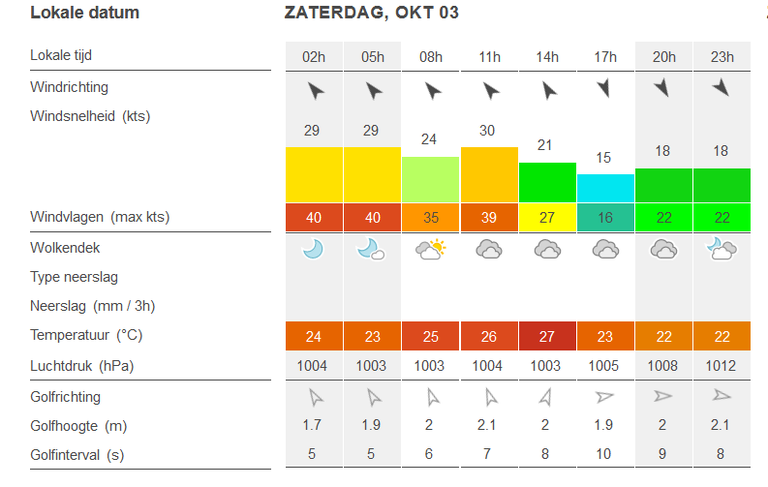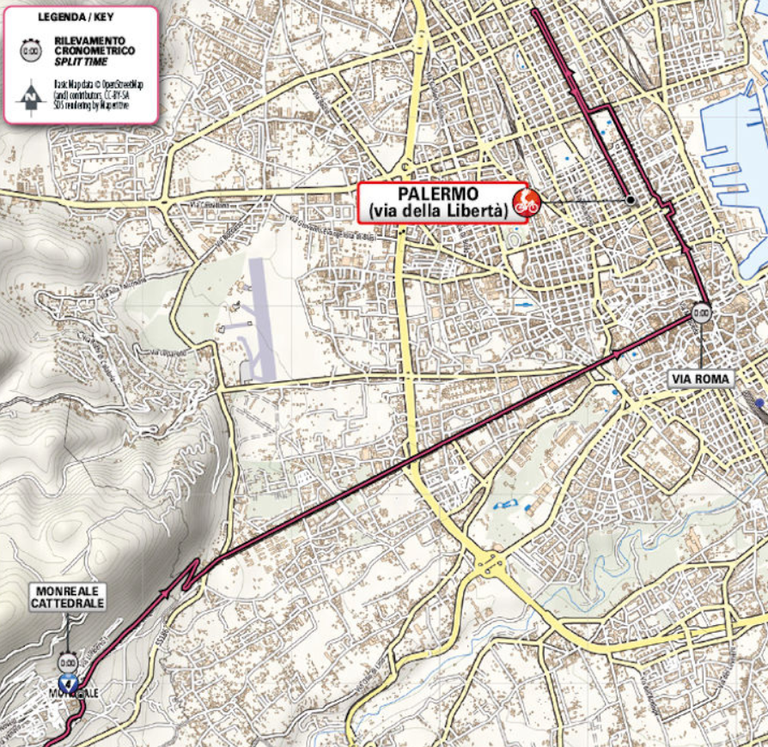Cycling pro Wilco Kelderman is certainly a good individual time trialist and he said in his post-race interview that he felt he rode a great prologue. Knowing this, we ask ourselves: Why did he lose over a minute to the early starters?. And more importantly: could we have predicted this loss? Rien Lagerwerf, PhD student at CWI's Computational Imaging group and cycling fan, sheds a light on this question:
To answer the question we will need to look at the weather conditions and the route of the prologue:

Weather prediction 16:00h, 03-10-20 for Sicily (in Dutch). Second row average wind speed in kts
If we look at the weather report we see that somewhere between 14:00 and 17:00 the wind turns from south-west to north-east and drops in power from 21 kts (38.9 km/h) to 15 kts (27.8 km/h). This in itself does not tell us anything, so let us look at the route of the prologue:

Route prologue Giro d'Italia 2020
Now this is interesting. We see the wind is directly on the side of the riders until the second chrono point (in both cases). This will be challenging for the riders as wind is very inconsistent in a city (passing a building can result in a heavy gust of wind) and will push the riders around, which — if you recall the footage — happened A LOT. Considering this you would think: “Ok, the wind is going to lie down later in the afternoon, this means there will be less risk of our riders crashing!”. Hold your horses. We only considered the first 9 km of the race, what about the last 6 km? Another thing you might be thinking is: “The wind direction does not change within a minute, it changes gradually. You are not taking this into account!” And yes, you would be right. But bear with me, I will get to that.
These km’s are roughly 3.5 km in the north-east direction and 2.5 km in the south-west direction. This means that the last 6 km you have a direct head/tail wind and more importantly the distance is not equal. This is the point where mathematics comes into play. Because with mathematics we can simulate the impact of the wind in the last 6 km! Ok. We learned a lot, lets recap:
</figure> Using this information we can simulate how the time trial would go for Wilco Kelderman in the two situations. Because the total distance is only 15 km a good time trialist can reach 7.5 watts per kilo, so lets say Wilco Kelderman can reach an average power of 490 watts. However, if you started early you would have to take less risks on the descent with the heavy side wind. So for the descent with an early start he would produce 450 watts. Time for simulations!
- Early afternoon:
- 9 km side wind,
- 3.5 km tail wind,
- 2.5 km head wind,
- Wind speed 38.9 km/h.
- Late afternoon:
- 9 km side wind,
- 3.5 km head wind,
- 2.5 km tail wind,
- Wind speed 27.8 km/h.

Table 1. Simulated times on the different segments.
From the results in Table 1 we directly see that the effect of the changing wind direction on the flat part of the prologue is more impactful than the increase of power you have on the descent. Which is quite surprising! But are these all the possible scenarios? No. We only computed the two extreme wind directions, but in reality the wind direction changes gradually. What about this case then? The wind gradually changed through the north. Meaning that during this change the riders would have a head wind during the first 9 km of the race and we do not need mathematics to see that this would lead to a slower time. Considering all these simulations we can conclude that the best weather scenario was in the early afternoon and guess what: We did not use any information from the post-race interviews or look at the actual results!
So do the results coincide with our simulations? Below we show the results for Chris Hamilton (teammate Kelderman and not a time trialist according to procyclingstats.com) Geraint Thomas, the big winner of the day from all the GC contenders, and Wilco Kelderman. We see that Kelderman lost time to his teammate on the climb and descent, where normally he should be faster. Indicating the wind had not completely turned and had an head wind on the first 9 km. This was also what the late starters said during their post-race interviews. And for the last 6 km? Kelderman lost 40 seconds in 6 km to Thomas, which coincides with the simulations that the last 6 km would be slower in the late afternoon.

Table 2. Starting times and race results
Lets go back to the questions I posed at the start of the post:
- Why did the late starters lose so much time?
The wind changed into an head wind for the majority of the course during the afternoon. This is not a surprising conclusion. The riders concluded this for themselves during the their interviews. The second question does have a surprising answer.
- Could we have predicted this loss?
Yes we could have predicted this! And in a way, we did so in this post. Because we concluded – using only mathematics, the route and the weather predictions – that you would only lose time by starting later in the afternoon.
Header photo: Unsplash
